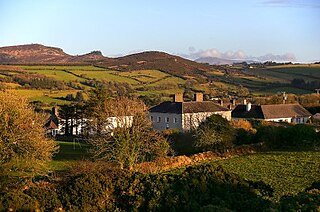Related Research Articles

Kilmallock is a town in south County Limerick, Ireland, near the border with County Cork, 30 km south of Limerick city. There is a Dominican Priory in the town and King's Castle. The remains of medieval walls which encircled the settlement are still visible.

Patrickswell, historically known as Toberpatrick, is a small town in County Limerick, Ireland. It is primarily a commuter village for people working in Limerick, including the nearby industrial suburb of Raheen. The population was 848 at the 2022 census.

John FitzGibbon, 1st Earl of Clare PC (Ire) was Attorney-General for Ireland from 1783 to 1789 and Lord Chancellor of Ireland from 1789 to 1802.

Seán South was a member of an IRA military column led by Seán Garland on a raid against a Royal Ulster Constabulary barracks in Brookeborough, County Fermanagh, Northern Ireland, on New Year's Day 1957. South, along with Fergal O'Hanlon from County Monaghan, died of wounds sustained during the raid. South has subsequently been commemorated as a martyr by Republicans.

Kilfinnane or Kilfinane is a small market town in County Limerick, Ireland. The town's name comes from the Irish Cill (church) and Fhíonáin (Finnian), making its meaning "Church of Saint Finnian". Kilfinnane is located approximately 40 km southeast of Limerick, and approximately 70 km north-northwest of Cork. It had a population of 789 at the 2016 census.
The Limerick Senior Hurling Championship is an annual hurling competition organised by the Limerick County Board of the Gaelic Athletic Association and contested by the top-ranking senior clubs in the county of Limerick in Ireland. It is the most prestigious competition in Limerick hurling.

The Battle of Kilmallock took place between 25 July and 5 August 1922 in County Limerick, Ireland. It was one of the largest engagements of the Irish Civil War.
Events from the year 1798 in Ireland.

The Diocese of Limerick and Killaloe was a former diocese of the Church of Ireland that was located in mid-western Ireland. The diocese was formed by a merger of neighbouring dioceses in 1976, before itself merging with the neighbouring Diocese of Tuam in 2022 to form the Diocese of Tuam, Limerick and Killaloe.

South Liberties is a Gaelic Athletic Association club based in County Limerick, Ireland. The club is based in the parish of Donoughmore-Knockea-Roxboro, on the southern outskirts of Limerick City and is affiliated to the East Board of Limerick GAA. It is one of the oldest clubs in the country, founded in 1884, the same year as the GAA. South Liberties' home ground in Ballysheedy is called Dooley Park, in memory of one of the club's greatest players. The club has won many county titles during its history, most notably seven Limerick Senior Hurling Championships; in 1888, 1889, 1890, 1972, 1976, 1978 and 1981. The club currently fields teams in the Senior hurling and Junior Gaelic football championships in Limerick.

Granagh-Ballingarry GAA is a Gaelic Athletic Association club based in west County Limerick, Ireland, within the jurisdiction of Limerick GAA. The club is situated near Knockfierna Hill, close to the villages of Granagh and Ballingarry. Granagh-Ballingarry GAA was formed in 1990 after the merger between Granagh and Ballingarry GAA clubs. Previously, the clubs had been playing together in some competitions.
Caherline GAA is a Gaelic Athletic Association club based in County Limerick, Ireland. It is based in the parish of Caherline/Caherconlish in the east division of Limerick GAA.

Mahoonagh or Castlemahon is a village and civil parish in County Limerick, Ireland. The village lies four kilometres south east of the town of Newcastle West.

Bruree is a village in south-eastern County Limerick, Ireland, on the River Maigue. It takes its name from the nearby ancient royal fortress, the alternative name of which from the earliest times into the High Middle Ages was Dún Eochair Maigue or the "fortress on the brink of the maigue". Other very old spellings and names include Brugh Righ, and Brugh Ri. The village is in a townland and civil parish of the same name.
Mannix Joyce was an Irish local historian and writer, known particularly for his publications on County Limerick.
Garryspillane GAA club is a Gaelic Athletic Association club located in the parish of Knocklong/Glenbrohane, County Limerick, Ireland. The club was founded in 1952 and is almost exclusively concerned with hurling with footballers catered for by neighbouring Galbally.
Ballylanders GAA is a Gaelic Athletic Association (GAA) located in the parish of Ballylanders/Knockadea in County Limerick. The club was founded in 1888 and is solely a Gaelic football club as hurlers from the parish play with neighbouring Glenroe. They won the County Senior Football Championship on four occasions in 1917, 1999, 2007 and 2014.
Charles Silver Oliver was an Irish landowner, the son of Silver Oliver, Member of Parliament for Kilmallock.
References
- ↑ Mainchin Seoighe, Staker Wallis: His Life and Times and Death, 1994, pp. 7–8, 43, 52–54.
- ↑ Maurice Lenihan, History of Limerick, 1866, reprint 1967, p. 405; Richard Hayes, "Some Notes on the United Irishmen and Limerick," North Munster Antiquarian Journal, vol. III, 1942, p. 118; both cited in Seoighe.
- ↑ Kilfinane and Bulgaden-Ballinvana parish baptism and marriage records, accessed by professional genealogist John McDermot, National Library of Ireland, January–February 2009.
- ↑ "Kane County IL - USGenWeb Archives". usgwarchives.net.
- ↑ "A Small Club Thinking Big". 18 May 2013.